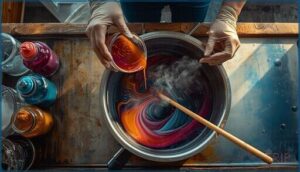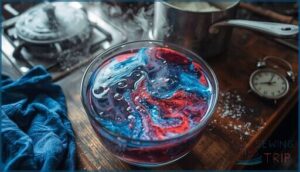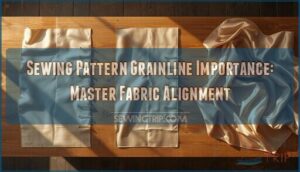This site is supported by our readers. We may earn a commission, at no cost to you, if you purchase through links.
Your favorite vintage band tee doesn’t have to stay faded, and that plain linen throw blanket holds more potential than you think. Fabric dyeing techniques for beginners transform ordinary textiles into customized pieces that reflect your style—no art degree required.
The process breaks down into manageable steps: gather your supplies, prep your fabric, apply color using simple methods like tie-dye or dip dyeing, then set and rinse. What stops most people isn’t the technique itself but uncertainty about where to start and how to avoid muddy colors or uneven results.
Once you understand fiber types, dye chemistry basics, and a handful of reliable methods, you’ll discover the freedom to rescue thrift store finds, breathe new life into old favorites, and create custom textiles that stores don’t sell.
Table Of Contents
Key Takeaways
- Fabric dyeing success hinges on three foundational choices: selecting natural fibers like cotton or linen for predictable dye absorption, using fiber-reactive dyes for lasting color on cellulose fabrics, and pre-washing textiles to strip factory residues that block up to 30% of dye penetration.
- Four beginner-friendly techniques offer distinct visual results—tie-dye creates controlled resist patterns through binding, ice dyeing produces unpredictable color splitting as powder migrates through melting ice, shibori delivers geometric designs via strategic folding and stitching, and ombré dyeing achieves smooth gradients through timed fabric immersion.
- Color vibrancy and longevity depend on precise process control: maintaining 60°C+ temperatures during fixation, washing dyed fabrics at 30°C or cooler to reduce fading by 15% per cycle, and storing pieces away from direct sunlight which can strip 50% of color intensity within six months.
- Eco-conscious dyeing reduces environmental impact significantly—natural plant-based dyes cut chemical exposure while proper disposal through municipal hazardous waste programs prevents textile wastewater from contributing to the 20% of global water pollution caused by the dyeing industry.
Essential Tools and Materials for Fabric Dyeing
Getting started with fabric dyeing means gathering the right tools and materials for the job. What you choose will shape your results and make the process smoother.
Here’s what you’ll need to set yourself up for success.
Choosing The Right Fabric
Choosing the right fabric sets the foundation for your dyeing adventure. Natural fibers like cotton, viscose, and linen deliver predictable dye absorption and vibrant results—cotton tops the list for beginners, with viscose offering even richer color saturation. Synthetic fibers demand specialized dyes and extra steps, making them trickier territory.
Focus on material preparation and fiber types to guarantee dye compatibility. Your fabric selection shapes everything that follows. Understanding natural dye options is vital for achieving desired colors.
Selecting Suitable Dyes
Once you’ve nailed your fabric, dye compatibility becomes your next playground. Fiber reactive dyes own cotton and linen with bulletproof color fastness, while acid dyes claim silk and wool. All-purpose dyes work across materials but sacrifice vibrancy. Synthetic options like disperse dyes release polyester’s potential.
Natural dyes and eco-friendly alternatives appeal to sustainability-minded creators, though they require patience and mordants for lasting results. Understanding the basics of natural dye processes is essential for achieving desired colors.
Gathering Basic Dyeing Supplies
Your dye types and fabric selection set the stage—now load up on the hardware that makes it real. Digital kitchen scales measure fabric weight accurately, with one Rit liquid dye bottle handling two pounds.
Grab a dedicated stainless steel pot, rubber gloves, plastic buckets for rinsing, squeeze bottles for precision application, and tongs for safe handling.
Starter supply kits bundle essentials at $10–$20, covering 20–36 projects with instruction booklets included.
Preparing Fabrics for Dyeing
With your supplies lined up, fabric preparation separates dull results from electric color. Fabric scouring strips oils and finishes—cotton and natural fibers absorb 24–55% more dye when pre-washed with mild detergent overnight.
Fabric hydration matters too: soak thoroughly before dyeing so color distributes evenly. This fiber preparation step boosts dye affinity and colorfastness testing scores, transforming preparing your fabric into the foundation for vibrant, lasting hues.
Safety and Environmental Tips for Beginners
Before you start mixing colors and binding fabric, you need to set up a workspace that keeps you safe and protects the environment around you.
Dyeing involves chemicals that demand respect, whether you’re using synthetics or plant-based alternatives.
Here’s what you need to know about protecting yourself, handling materials responsibly, and choosing options that won’t harm the planet.
Protective Gear and Workspace Setup
Think of your workspace as a stage where safety takes the spotlight—because you can’t create fearlessly if you’re breathing in chemicals. Set up in a well-ventilated area with at least six air changes per hour to control vapor buildup.
Wear N95 respiratory masks when handling powdered dyes, chemical gloves to prevent skin contact, and safety goggles against splashes. Keep non-porous work surfaces clean and always have eyewash stations within reach.
Safe Dye Handling and Disposal
Before you pour leftover dye down the drain, understand that textile wastewater drives nearly 20% of global water pollution—and that rebellious spirit means taking responsibility.
Textile wastewater fuels 20% of global water pollution—true rebellion means taking responsibility for what you pour down the drain
Chemical safety starts with dye waste management: never dump concentrated dyes into sinks or soil. Use municipal hazardous waste programs for sustainable disposal, rinse vessels thoroughly, and prevent color bleeding by washing dyed fabrics separately to protect waterways while dyeing fabric safely.
Eco-Friendly Dye Options
Freedom lies in choosing natural dyes and eco-friendly dyes that honor both craft and planet. Plant-based organic pigments from indigo, madder, and turmeric reduce chemical exposure while supporting sustainable textiles.
Green chemistry innovations cut water use by 75% and slash carbon emissions, proving sustainable fashion doesn’t mean compromising vibrancy.
Fabric dyeing techniques using eco dyeing methods let you create boldly while treading lightly on earth.
Beginner-Friendly Fabric Dyeing Techniques
You’ve got your workspace ready and your materials lined up—now it’s time to get your hands into the actual dyeing. Each technique gives you a different level of control over how color hits your fabric, from wild, unpredictable bursts to smooth, intentional gradients.
Let’s break down four beginner-friendly methods that’ll help you start creating patterns and effects you can actually see taking shape.
Tie-Dye Method
If you’ve ever craved that retro magic of spirals and bursts, tie-dye is your gateway. This resist dye method uses folding techniques and rubber bands to block color, creating patterns that range from classic bullseyes to wild radiating circles.
With fiber-reactive dyes and soda ash for dye fixation, you’ll lock in vibrant hues. Understanding color theory helps you mix shades without muddy disasters—it’s introduction to tie-dye at its boldest.
Ice Dyeing Process
Ice dyeing flips the script—you scatter powdered reactive dye over scrunched fabric buried under ice, then watch color splitting magic unfold as ice melting releases unpredictable abstract patterns.
Dye concentration matters: start with 1–4% of fabric weight for vivid results without waste.
This beginner-friendly dyeing method thrives on chaos, delivering one-of-a-kind designs through fabric scrunching and zero control—perfect for rebels who love dyeing fabric at home.
Shibori Dyeing Basics
Shibori dyeing techniques transform fabric through twisting, stitching, and fabric folding—resist techniques that Japanese artisans perfected centuries ago. You’ll bind cotton or silk before plunging it into indigo dye baths, creating shibori patterns from controlled chaos.
Natural dyes react beautifully with strategic shibori folding methods, delivering bold geometric designs or organic textures. This shibori dyeing method rewards experimentation—each bind creates unrepeatable fabric dyeing techniques for beginners seeking authentic artisan results.
Ombré and Dip Dyeing Techniques
Where shibori creates sharp contrast through binding, ombré dyeing delivers smooth color gradients by gradually immersing fabric into dye baths. You’ll suspend your cotton or linen vertically, controlling depth within 2 centimeters for precise dip dyeing results. Immersion dye techniques require 20+ minutes of continuous movement to prevent harsh lines—each minute deepens saturation by roughly 4%.
- Salt additives boost dye fixation on natural fibers by up to 17%
- Ombre dip dye methods produce two-tone effects with soft boundaries
- Fabric resistance decreases with longer immersion times, intensifying ombré effects
- Final colors appear 18–25% lighter after washing than wet fabric shows
Step-by-Step Guide to Dyeing Fabric at Home
Now that you’ve picked your technique, it’s time to roll up your sleeves and get your hands into the dye. This step-by-step process walks you through the entire journey—from prepping your fabric to caring for your finished piece.
Follow these four stages to transform plain textiles into vibrant, custom creations that last.
Preparing and Wetting Fabric
Preparing your fabric isn’t just a preliminary chore—it’s the foundation for explosive color. Start with a thorough prewash to strip away factory residues that block dye absorption. Then, soak your fabric for 15–30 minutes in room-temperature water. This fabric preparation step activates capillary action, boosting dye uptake by 40%. Wetting agents can further improve moisture control for impeccable results.
| Fabric Preparation Step | Impact on Dye Absorption |
|---|---|
| Remove waxes and oils | Up to 30% better penetration |
| Pre-soak 15–30 minutes | 40% faster dye uptake |
| Use wetting agents | Reduces surface tension by 50% |
| Maintain 1:10 liquid ratio | Ensures even color distribution |
| Control moisture at 8–12% | Prevents dye migration and uneven shades |
Mixing and Applying Dye
Once your fabric is primed, you’re ready to mix dye. For fiber-reactive types, use 1 tablespoon per pound of fabric—quadruple that for deep shades. Dissolve powder completely in hot water, then adjust pH to alkaline levels for maximum dye fixation.
Apply dye using:
- Submersion in a 1:10 material-to-liquor ratio tub
- Squeeze bottles for precise tie-dye placement
- Spray methods for soft, variegated effects
- Continuous stirring to prevent blotching
- Spectrophotometric monitoring for color accuracy
Stir constantly—uniformity depends on it.
Setting and Rinsing The Dye
After dye application, heat or fixative compounds lock color into fibers—dye fixation temperatures above 60°C boost retention rates. Let fabric rest 24 hours for maximum color fastness.
Then rinse thoroughly in cold water to prevent bleeding; cold rinses cut dye loss by nearly half compared to hot. Wash separately for the first three cycles.
This post-dye care protects your bold, rebellious patterns while conserving water throughout the dyeing process.
Drying and Caring for Dyed Fabrics
Proper drying seals your creative rebellion into every fiber. Lay dyed fabrics flat in shaded, well-ventilated spots—sunlight steals up to 18% more color over time, and folded layers trap moisture, creating uneven tones.
- Air dry away from direct UV exposure to prevent color fading and maintain dye fixation
- Avoid heat pressing until completely dry to stop color migration across fabric
- Wash with pH-neutral detergents for colorfastness and reduced fabric shrinkage
- Use color-protecting formulas cutting fading by 25–40% following laundry tips
- Follow care instructions closely for lasting vibrancy in your dyed textiles
Tips for Achieving Vibrant and Lasting Colors
Getting bold, saturated color that actually sticks around takes more than just dumping dye on fabric and hoping for the best. You’ll need to understand a few key principles about color mixing, fabric care, and common pitfalls that can leave your work looking washed out or uneven.
Here’s what you need to know to make your dyed pieces pop and stay vibrant wash after wash.
Color Mixing Basics
Think of color theory as your rebellion against boring, one-dimensional fabric. You’ll discover infinite color variations by mastering dye ratios and mixing formulas—red and blue yield violet, yellow and blue create green.
Start with these primary hue selections:
| Primary Mix | Dye Ratios | Result |
|---|---|---|
| Yellow + Red | 1:1 | Orange |
| Red + Blue | 1:1 | Violet |
| Blue + Yellow | 1:1 | Green |
Tint creation happens when you dilute colors with water, while color blending demands precise mixing formulas for colorfastness.
Avoiding Common Dyeing Mistakes
Pitfalls in fabric dyeing are easier to dodge when you know where they hide. You’ll sidestep uneven dye application—which causes 32% of common faults—with these practical fabric preparation tips:
- Never overload your dye bath; it creates 40% more patchy results
- Pre-wet fabric completely to prevent white spots
- Remove all oils before dyeing
- Add dye gradually, not rapidly
- Rinse thoroughly for color bleeding prevention
Caring for Dyed Fabrics Long-Term
Your dyed creations deserve liberation from premature fading. Washing dyed items at 30°C or cooler slashes color loss by 15% per cycle, while turning garments inside out extends vibrancy by 30% annually.
Store your fabric away from heat and sunlight—direct rays strip 50% of intensity in six months.
Hand washing with ecological detergents preserves plant-dyed colors 25% longer, ensuring your rebellious hues stay bold.
Experimenting With Patterns and Effects
Ready to break free from predictable patterns? Shibori folding techniques reveal over 15 unique designs, while tie-dye spirals and crumples yield 10 distinct effects through fabric manipulation. Ice dyeing delivers multi-chromatic surprises in 87% of attempts—pure creative rebellion.
Adjust your dye bath pH between 5.5 and 7.0 to sharpen pattern edges by 36%. Ombré dyeing and resist dye methods transform textile design into personal artistry through fearless immersion dye experimentation.
Frequently Asked Questions (FAQs)
How do you dye fabric for beginners?
Start with natural fibers like cotton or linen—they’re forgiving and absorb dye beautifully.
Gather your dye, fixative, gloves, and a bucket. Wet your fabric, mix the dye following package instructions, then immerse and stir.
What are the methods of fabric dyeing?
You’ll encounter batch dyeing, continuous methods, and resist techniques like Shibori and tie-dye.
Immersion dye processes use fiber reactives or natural dyes, while resist dyeing and ombré dyeing offer creative pattern control.
How to dye fabric with clean lines?
For line clarity worthy of a master’s touch, lean on resist techniques like masking tape or wax barriers.
Tight-weave fabrics and controlled dye precision with brushwork guarantee edge definition that won’t bleed or blur.
What do we soak the fabric in before we apply the dye?
You’ll soak fabric in a soda ash solution—1 cup per gallon of warm water for at least 20 minutes.
This pre-soak raises pH, helping fiber reactive dyes bond permanently at room temperature.
Whats the difference between ice dyeing and tie-dyeing?
Ice dyeing creates organic, watercolor-like patterns with dramatic color splitting as powdered dye migrates through melting ice.
Tie-dye uses liquid dye for controlled placement, producing uniform blocks of color with predictable resist dye patterns.
Which technique should I use for a simple gradient effect?
For simple gradient effects, ombré dip dyeing delivers the smoothest color transitions.
You’ll gradually immerse your fabric, controlling how long each section sits in the dye bath—this technique offers beginners outstanding gradient control with minimal equipment.
Can I use natural dyes for shibori?
Absolutely—you can use natural dyes for shibori, and they’re wildly popular. Plant-based colors like indigo, onion skins, and marigold deliver stunning shibori patterns while remaining eco-friendly dyes with solid colorfastness.
What is the best fabric for beginners to start with?
Cotton stands as your go-to fabric for dyeing at home—it’s forgiving, takes color beautifully, and delivers reliable results every time.
Natural fibers like linen work well too, offering excellent dye compatibility for beginners.
How do I create a galaxy print?
Think you can paint the cosmos on cotton? Galaxy print techniques blend tie-dye and ombré dyeing with cosmic color theory—twist fabric, layer purples and blues, then splatter white stars for those starry night effects everyone craves.
Can you dye fabric with food coloring?
You can dye fabric with food coloring—it works best on wool and silk when you pre-soak in vinegar and simmer.
Expect pastel shades with limited color fastness compared to commercial dyes.
Conclusion
A blank canvas waits for the first stroke—fabric dyeing works the same way. You’ve got the tools, the methods, and the confidence to start transforming textiles on your terms.
These fabric dyeing techniques for beginners aren’t about flawlessness; they’re about claiming creative control over what you wear and display. Mix colors boldly, test patterns fearlessly, and let mistakes teach you.
Your workspace is ready. The only question left: which piece will you revive first?
- https://www.thegoodtrade.com/features/diy-natural-fabric-dye/
- https://www.carbonfact.com/blog/knowledge/yawa-waterless-dyeing
- https://www.alchemietechnology.com/news/digital-textile-dyeing-breakthrough-solution-water-crisis/
- https://www.earlham.ac.uk/case-study-driving-sustainable-fashion-revolution
- https://finance.yahoo.com/news/natural-dyes-market-set-usd-133000371.html














